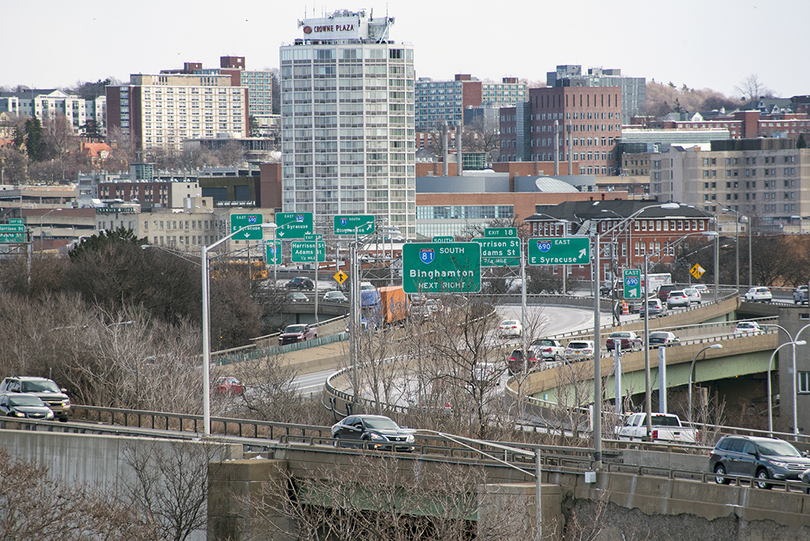Syracuse’s drinking water could indirectly be contaminated by the I-81 replacement project, some officials believe

Skaneateles Lake and Owasco Lake are located about 20 and 30 miles southwest of Syracuse, respectively. Wasim Ahmad | Staff Photographer
Syracuse’s drinking water could be indirectly contaminated by the Interstate 81 replacement project in the city, officials and residents from the Finger Lakes region said.
Some warned that Skaneateles Lake, the city’s main source of water, could be exposed to toxic material because of a truck accident, although experts said it’s unlikely a spill like the one described by multiple officials and residents would occur or drastically affect the city’s water supply.
The New York State Department of Transportation has been reviewing for years how to replace I-81 in Syracuse, which is expected to reach the end of its useful life in 2017. Recently, the state announced that a consulting firm, WSP/Parsons Brinckerhoff, would review all options for the replacement of the viaduct, including tunnel options that had previously been dismissed by the state.
Officials from areas surrounding Skaneateles Lake and Owasco Lake in interviews said the community grid option proposed by the state — which would reroute interstate traffic east around Syracuse on what is now Interstate 481 — would increase the number of long haul trucks using small state highways in their towns and villages to cut west across New York state.
Skaneateles Lake and Owasco Lake are located about 20 and 30 miles southwest of Syracuse, respectively.
The issue has been ongoing for years, said James Lanning, the town of Skaneateles supervisor. New York City garbage trucks, bringing waste to landfills in Seneca Falls, frequently use highways such as State Route 41 and 41A that run alongside Skaneateles Lake, instead of taking I-81 north to Syracuse before cutting west on Interstate 690, Lanning said.
The community grid’s proposed detour around Syracuse — and the I-81 project’s construction in the city — will only exacerbate the issue, Lanning said. The increase in truck traffic could lead to a garbage truck having an accident and dumping potentially hazardous material into the lake or the lake’s tributaries, he said.
“It would be very difficult to contain,” Lanning said, referring to a potential contamination of the lake.
But experts said this potential truck spill is unlikely to occur or, if it did, impact the drinking supply of the city.
“It’s not entirely to be discounted. But that being a primary concern of the change in traffic patterns doesn’t seem very realistic,” said Stephen Shaw, an assistant professor of environmental resources engineering at the State University of New York College of Environmental Science and Forestry.
Skaneateles Lake’s large size — it is approximately 16 miles long and one and a half miles wide, and has a maximum depth of 300 feet — would dilute most toxic or hazardous material, he said. If it were a river, Shaw said he might understand officials’ and residents’ concerns, with a river moving fast and not diluting the spill.
Shaw said several different events would have to happen for a significant amount of toxin to enter the Syracuse water supply. A truck carrying some hazardous material would first have to crash into the lake close to the water intake pipe near the northern end of the lake, he said. That means a truck would have to drive off State Route 20 in Skaneateles, drive over the beach, before then crashing into the water and releasing a significant amount of the material, giving city officials little time to shut off the pipe.
Ray Bromley, a professor in the State University of New York at Albany’s geography and planning department, added that he doesn’t think it’s a strong argument for officials and residents to correlate the reroute of I-81 with trucks contaminating the lake.
Skaneateles Lake has “exceptionally high” water quality, according to Syracuse’s 2015 annual drinking water quality report, which is why the lake is one of the few large surface water supplies in the United States without a filtration system. Lake water enters an intake pipe near the north end of lake and is sent to the Woodland and Westcott reservoirs, among other places, for storage on the west side of the city, where the water has “minimal treatment.”
Syracuse has been using Skaneateles Lake as its main source of water since 1894, according to the report.
Holland “Holly” Gregg III, founder of the Citizens to Preserve the Character of Skaneateles group, said his main concern isn’t a spill impacting the water supply, but the possibility of a spill influencing state officials to install a filtration system for Skaneateles Lake. Gregg estimated the filtration system would cost $100 million, with Skaneateles having to pay 10 percent of that figure.
Gregg, Lanning and Wagner all said they support the tunnel replacement option for I-81.
“There’s a real looming economic problem here, that is out there, that is very easy to just not think about,” Gregg said.




